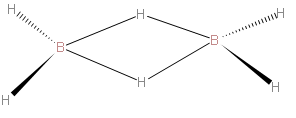
B−H−B bridge in \[{{B}_{2}}{{H}_{6}}\]is formed by sharing of:
(A) 2 electrons
(B) 4 electrons
(C) 1 electrons
(D) 3 electrons
Answer
221.4k+ views
Hint: To answer this question, we should first draw the structure of diborane. When we draw the structure of a diborane, then only we can tell the number of electrons in the BHB bridge.
Complete step by step solution:
> We should first know about diborane. It has the chemical formula of \[{{B}_{2}}{{H}_{6}}\]. - It is the chemical compound consisting of boron and hydrogen with the formula \[{{B}_{2}}{{H}_{6}}\]. So first we will draw the structure of Diborane. We should carefully draw the structure of Diborane. We should know that four hydrogen in diborane are attached to terminals, while two hydrogens act as bridges between the boron centers. We should understand that the lengths of the B-H bridge bonds and the B-H terminal bonds are 1.33 and 1.19 Å, respectively. This difference in bond lengths reflects the difference in their strengths, the B-H bridge bonds being relatively weaker.

> The above structure represented is of \[{{B}_{2}}{{H}_{6}}\]..
As we draw the structure of\[{{B}_{2}}{{H}_{6}}\], it describes the bonds between boron and the terminal hydrogen atoms as traditional 2-center, 2-electron covalent bonds. The bonding between the boron atoms and the bridging hydrogen atoms is, however, different from that in molecules such as hydrocarbons. We know that boron uses two electrons in bonding to the terminal hydrogen atoms, and has one valence electron remaining for additional bonding. The bridging hydrogen atoms provide one electron each. The \[{{B}_{2}}{{H}_{2}}\] ring is held together by four electrons which form two 3-center 2-electron bonds. This type of bond is sometimes called a 'banana bond'.
> So, from the above discussion, we came to know that the B-H-B bridge in \[{{B}_{2}}{{H}_{6}}\] is formed by sharing two electrons. Therefore correct option is (A).
Note:We should note that diborane can be used as a rocket propellant. The complete combustion of diborane is strongly exothermic. But we should also know that this shows the similarity with carbon monoxide and doesn’t burn completely.
Complete step by step solution:
> We should first know about diborane. It has the chemical formula of \[{{B}_{2}}{{H}_{6}}\]. - It is the chemical compound consisting of boron and hydrogen with the formula \[{{B}_{2}}{{H}_{6}}\]. So first we will draw the structure of Diborane. We should carefully draw the structure of Diborane. We should know that four hydrogen in diborane are attached to terminals, while two hydrogens act as bridges between the boron centers. We should understand that the lengths of the B-H bridge bonds and the B-H terminal bonds are 1.33 and 1.19 Å, respectively. This difference in bond lengths reflects the difference in their strengths, the B-H bridge bonds being relatively weaker.

> The above structure represented is of \[{{B}_{2}}{{H}_{6}}\]..
As we draw the structure of\[{{B}_{2}}{{H}_{6}}\], it describes the bonds between boron and the terminal hydrogen atoms as traditional 2-center, 2-electron covalent bonds. The bonding between the boron atoms and the bridging hydrogen atoms is, however, different from that in molecules such as hydrocarbons. We know that boron uses two electrons in bonding to the terminal hydrogen atoms, and has one valence electron remaining for additional bonding. The bridging hydrogen atoms provide one electron each. The \[{{B}_{2}}{{H}_{2}}\] ring is held together by four electrons which form two 3-center 2-electron bonds. This type of bond is sometimes called a 'banana bond'.
> So, from the above discussion, we came to know that the B-H-B bridge in \[{{B}_{2}}{{H}_{6}}\] is formed by sharing two electrons. Therefore correct option is (A).
Note:We should note that diborane can be used as a rocket propellant. The complete combustion of diborane is strongly exothermic. But we should also know that this shows the similarity with carbon monoxide and doesn’t burn completely.
Recently Updated Pages
The hybridization and shape of NH2 ion are a sp2 and class 11 chemistry JEE_Main

What is the pH of 001 M solution of HCl a 1 b 10 c class 11 chemistry JEE_Main

Aromatization of nhexane gives A Benzene B Toluene class 11 chemistry JEE_Main

Show how you will synthesise i 1Phenylethanol from class 11 chemistry JEE_Main

The enolic form of acetone contains a 10sigma bonds class 11 chemistry JEE_Main

Which of the following Compounds does not exhibit tautomerism class 11 chemistry JEE_Main

Trending doubts
JEE Main 2026: Application Form Open, Exam Dates, Syllabus, Eligibility & Question Papers

Derivation of Equation of Trajectory Explained for Students

Hybridisation in Chemistry – Concept, Types & Applications

Understanding the Angle of Deviation in a Prism

How to Convert a Galvanometer into an Ammeter or Voltmeter

Degree of Dissociation: Meaning, Formula, Calculation & Uses

Other Pages
NCERT Solutions For Class 11 Chemistry Chapter 7 Redox Reaction

JEE Advanced Marks vs Ranks 2025: Understanding Category-wise Qualifying Marks and Previous Year Cut-offs

Hydrocarbons Class 11 Chemistry Chapter 9 CBSE Notes - 2025-26

Thermodynamics Class 11 Chemistry Chapter 5 CBSE Notes - 2025-26

NCERT Solutions ForClass 11 Chemistry Chapter Chapter 5 Thermodynamics

Equilibrium Class 11 Chemistry Chapter 6 CBSE Notes - 2025-26




